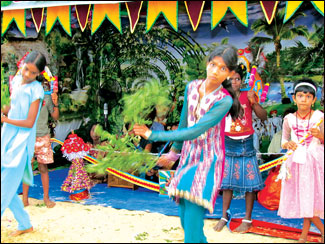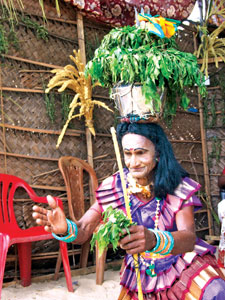Jaffna Music Festival enthralls audiences
By Thulasi MUTTULINGAM
Jaffna afforded an opportunity for artistes to come on a common
platform and showcase their talents and abilities.
 |
|
On the opening day of the
festival |
The much anticipated and spirited Jaffna Music Festival (JMF) has
concluded. It was an exhilarating three nights filled with diverse forms
of folk music and dance and artistes participated in workshops for three
days.
This was a meeting of Northern, Southern, Eastern and Hill Country
Artistes in one setting for the first time - their joy at being able to
mingle with others and exchange notes for the first time in their lives.
The happiness of the elderly Jaffna folk artistes who had thought
that dance and music they had practised as youth had withered but saw it
being revived in their lifetime and passed on to another generation,
that exhibits a lively interest to keep it alive.
One of the much talked about troupes was from Muliawalai of
Mullaitivu. Apparently Muliawalai had once been famous for its kootu
(musical/dance drama) performances but the people had relocated during
the war against terrorism and their art had all but died out. The JMF
organisers had taken much trouble to seek artistes and get a few of them
to don their costumes and dance again. When I visited the hut where this
troupe performed on hearing about them, I met their oldest member,
79-year Ramupillai. He looked much more than his years on his chair,
seemingly too weak to talk. He looked so frail and weak. A while later,
attracted by the crowd and applause round this hut, I returned to see a
pretty woman, who also was quite old dancing with a pot balanced on her
head.
|

79-year old Ramupillai doing his act |
Very rhythmic, graceful and agile. "Who is this?" I asked, since I
had seen only one female member in the troupe and she was still in her
chair. "Oh that's the 79-year-old Ramupillai - remember, you met him a
while ago?" If I had not seen the dance myself I might not have believed
it; when the costume and make-up was off, he went back to being the
frail old man I had earlier seen and who had to be led by the hand. The
love of his art was so ingrained in his mind and body that it
transformed him when he performed, into a much younger person, with an
energy and flair that he otherwise did not possess.
In another hut nearby, the Palestinian troupe from the SABREEN
Association, were espousing their music. Since they sang popular Arab
ballads, they were a huge hit with the crowd, who wanted "One More!" A
Kandyan drummer from a nearby hut had taken the opportunity, during a
lull in performances to get some drumming lessons from the Palestinian
drummer.
Both impromptu guru and student were for a time oblivious to the
crowd around them, who enjoyed the spectacle of watching two artistes
from different cultures and spheres, share their love of a common
instrument. The drums in all its varied models, styles and rhythms were
a big hit with the crowd.
The drummer from Palestine was just one member of a troupe but his
presence was felt and appreciated as was the drummer from the Nepali
troupe and Kandyan drummers.
One of the highlights of the show was the Parai Drummers. In India,
these traditional drummers have made great strides in regaining their
lost dignity and pride and having their art recognised but Sri Lanka
still has a long way to go.
Long marginalised and subjugated under caste and social structures,
the Parai drummers of the North have been marginalised from practising
their drums anywhere other than at funerals.
At one time in history, they were the message bearers of Kings and
had developed rhythms to convey messages to people.
They used their drums to proclaim royal edicts, celebrate temple
festivals, marriages as well as funerals.
They used their drums to evocatively incite the appropriate moods in
people, whether it be joy, anticipation, celebration, sadness or fear.
However, with their subjugation as a race, went the subjugation of their
art, which has mostly withered in the North.
Fortunately, Goddess worship, prevalent in the East, in which the
Parai drummers play an important part, kept some of their art alive in
the Batticaloa region.
The performers at JMF 2011 consisted of a lecturer and his students
at the Eastern University, not traditional drummers.
They did a very creditable job but having seen the original
performers in India, they fell a little short.
There will inevitably be a difference between a performer whose
forefathers have performed a certain art for centuries and passed it
down to him and performers who learn the instrument at University for a
few years.
On the second day of the Jaffna Music Festival, a massive
breakthrough was made when the Parai drummers were widely cheered and
welcomed on stage - but they were cheered as University Students, by
University students.
I look forward to the day when traditional practitioners of the art,
could stand on such a stage too and proclaim their pride in having
perfected and kept alive a unique art in the face of great adversity.
They deserve that space and that glory.
The daytime workshops were highly educative, with the artistes
patiently performing and explaining their art, seemingly oblivious to
the scorching sun and the night time performances were an extravaganza
of colour, rhythm and music, in all its diversity.
Five International groups, from Norway, Palestine, India, Nepal and
South Africa performed.
They were all big hits with the crowd. Norway was represented by a
three-member all female band named, Tindra (Sparkle), who had searched
out their ancestors' folk songs in library archives as their parents'
generation had lost it.
The songs were of child shepherds singing to overcome their
weariness, of a shepherd and shepherdess singing of their love and their
illegitimate child in code (apparently they were not allowed to marry by
their feudal owners to ensure their commitment to the owners and not
have lives/cares of their own), of 19th century immigrants to America
yearning for their longing for their motherland interspersed with many
funny songs about cats, goats, young men and women making human mistakes
and doing eccentric things.
The lead singer had a lovely evocative voice, which held the audience
spellbound and expressed the appropriate emotions needed for the songs,
whether it was sadness, loneliness or humour rendered so beautifully.
Some were professional in showing the best of themselves within 20
minutes. Some were not; Quite a few of the Jaffna troupes were used to
spinning a story for 12 hours in temple courtyards, from dusk till dawn.
It was beyond them to tell a
coherent story in 20 minutes - but as captured and will be telecast
on Rupavahini - they showcased a bit of their dance, music and art, to
be seen by the rest of the country, which has never been seen before.
It's a beginning!
The Jaffna Music Festival 2011 was the first of its kind to be held
and it's hoped will be held every other year. It will alternate with its
sister event, the Galle Music Festival. This year, the theme of the
festival held from March 25-27 was folk art and music. It was funded by
the Royal Norwegian Embassy and USAID and launched by Sewalanka
Foundation, Concerts Norway and Aru Sri Art Theatre. |

